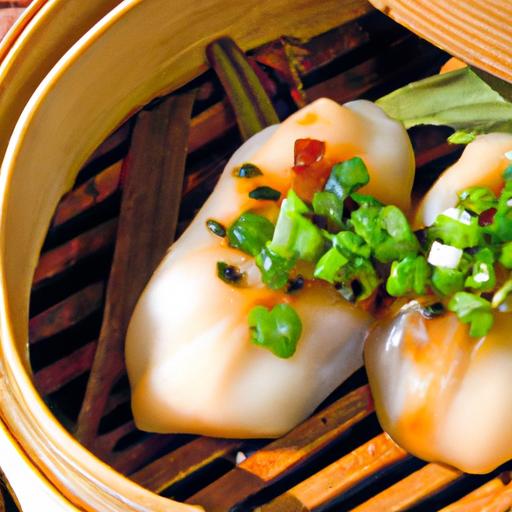In the world of culinary tradition, few tools evoke the delicate dance of flavor and texture quite like the bamboo steamer. Woven from natural fibers and steeped in centuries of history, these humble baskets are more than simple kitchen vessels-they are gateways to a cooking method that transforms ingredients with gentle, aromatic steam. From bustling street markets in Asia to modern gourmet kitchens worldwide, bamboo steamers carry the legacy of ancient cooking magic, preserving nutrients, enhancing taste, and creating dishes that feel both timeless and vibrant. Join us as we unravel the secrets behind bamboo steamers, exploring their origins, construction, and the subtle alchemy they perform with every layer of steaming goodness.
Bamboo Steamers: Ancient Cooking Magic Explained
Bamboo steamers unlock a world where simplicity meets elegance, transforming humble ingredients into vibrant culinary treasures. Steaming over time-honored bamboo baskets has been a cornerstone of Asian cooking for centuries, infusing dishes with a delicate texture and retaining natural flavors. Whether you’re craving soft, fluffy buns or tender, perfectly cooked vegetables, mastering the art of bamboo steaming elevates your kitchen prowess and connects you with an ancient culinary tradition.
Prep and Cook Time
- Preparation: 15 minutes
- Cooking: 20-30 minutes (depends on ingredients)
Yield
Serves 4 generously, suitable for a delightful family meal or elegant appetizer spread.
Difficulty Level
Medium – Requires attention to steaming timing and proper use of the bamboo steamer.
Ingredients
- 500g fresh vegetables (bok choy, broccoli, or carrots, sliced)
- 12 homemade or store-bought dumplings (pork, vegetable, or shrimp-filled)
- 2 tbsp soy sauce
- 1 tbsp toasted sesame oil
- 1 inch fresh ginger, thinly sliced
- 2 cloves garlic, minced
- 1 cup water (for steaming)
- Optional garnish: chopped scallions, sesame seeds, and fresh cilantro
Instructions
- Prepare the steamer: Soak your bamboo steamer in warm water for 10 minutes to prevent cracking and sticking. Line each tier with parchment paper or cabbage leaves to keep the ingredients from sticking.
- Set up your steaming pot: Fill a wok or large pot with 1 cup of water, ensuring the water level is below the bottom tier of the steamer. Bring it to a gentle boil over medium heat.
- Arrange the ingredients: Place the sliced vegetables on the first tier, making sure not to overcrowd so steam can circulate freely. Add the dumplings in a single layer on the top tier.
- Steam with care: Stack the tiers and cover with the bamboo lid. Steam for 15 to 20 minutes-vegetables should be tender but still bright, dumplings cooked through and plump. Avoid lifting the lid during steaming to preserve heat and moisture.
- Create the dipping sauce: While steaming, mix soy sauce, sesame oil, sliced ginger, and minced garlic in a small bowl. Adjust seasoning to taste.
- Serve immediately: Carefully remove the steamer from heat using pot holders. Garnish with scallions, sesame seeds, and cilantro for that restaurant-quality presentation.
Tips for Success
- Stack and Rotate: If using multiple tiers, swap tiers halfway through cooking to ensure even steaming.
- Water Level Awareness: Never allow the boiling water to touch the steamer bottom to avoid sogginess-replace water if it evaporates too quickly.
- Broader Vegetables: Cut vegetables in uniform sizes to cook evenly; thicker vegetables may require extra steaming time.
- Flavors to Explore: Experiment by infusing water with lemon slices or star anise for delicate aromatic notes.
- Storing Steamers: Dry bamboo steamers in a well-ventilated area to prevent mold and extend their lifespan.
Serving Suggestions
Present your steamed delights on rustic wooden platters or delicate ceramic dishes that enhance the warm, natural aesthetic of bamboo steaming. Complement the dish with dipping sauces-soy-based, chili oil, or even a tangy ponzu. Pair steamed vegetable medleys with jasmine rice or light noodles tossed in sesame oil for a balanced, nutritious feast ideal for sharing.

| Nutrient | Amount per Serving |
|---|---|
| Calories | 180 kcal |
| Protein | 8 g |
| Carbohydrates | 25 g |
| Fat | 4 g |
For a deeper dive into traditional Asian cooking methods and complementary recipes, explore our guide to Asian cooking techniques. Additionally, the National Geographic insight on bamboo steamers offers fascinating historical context on their craft.
Q&A
Q&A: Bamboo Steamers – Ancient Cooking Magic Explained
Q1: What exactly is a bamboo steamer?
A1: Imagine a stack of woven baskets, each cradle-like and airy, nestling your food gently above simmering water. That’s a bamboo steamer – a traditional cookware made from natural bamboo strips woven into breathable trays that let steam dance through and cook your food with delicate precision.
Q2: How old is this cooking method?
A2: Bamboo steamers are culinary time machines, dating back over 1,000 years in ancient China. They’ve journeyed through centuries, carried by emperors and villagers alike, preserving flavors while embracing simplicity and sustainability.
Q3: Why use bamboo instead of metal or plastic?
A3: Bamboo is not just a humble plant; it’s a master of balance. It breathes and absorbs excess moisture, preventing sogginess and keeping dumplings fluffy, veggies crisp, and fish tender. Plus, bamboo steamers don’t drip condensation back onto food like metal ones-they create a perfect, natural cooking environment.
Q4: What kinds of dishes work best in bamboo steamers?
A4: The bamboo steamer is a versatile maestro in the kitchen orchestra-think delicate dim sum, hearty buns, flaky fish, vibrant vegetables, or even aromatic rice cakes. The gentle steam cooks evenly, preserving nutrients and textures while infusing a subtle woody aroma.
Q5: How do you use a bamboo steamer?
A5: Set the steamer over a pot or wok of simmering water-never boiling, lest the bamboo crack. Stack your ingredients on parchment or banana leaves, layer the baskets, cover with the lid, and let the magic of steam work its quiet alchemy. It’s cooking with a whisper, not a roar.
Q6: How do you care for a bamboo steamer?
A6: Treat it tenderly! After use, rinse with warm water, avoid soap to protect bamboo’s natural oils, and air dry thoroughly to prevent mold. With care, your bamboo steamer grows wiser and more durable, a seasoned partner in your culinary adventures.
Q7: Can using a bamboo steamer make your cooking healthier?
A7: Absolutely. Steaming locks in vitamins and minerals while requiring no oil or fat, making your meals lighter, juicier, and bursting with natural color and flavor. It’s ancient health wisdom wrapped in fragrant steam.
Q8: Is bamboo sustainability part of its magic?
A8: Yes, bamboo grows fast and cleans the air while it thrives. Using bamboo steamers supports eco-friendly cooking, marrying tradition with today’s environmental mindfulness-a delicious way to honor the earth and your appetite at once.
Unlock the secrets of bamboo steamers and you step into a kitchen ritual as ancient as time, where nature and nourishment meet in a swirl of steam and flavor.
Closing Remarks
As the gentle steam rises and wisps through the bamboo slats, it carries with it centuries of tradition, flavor, and innovation. Bamboo steamers are not just simple kitchen tools-they are vessels of ancient culinary wisdom, connecting us to a time when food was cooked with patience, care, and harmony with nature. By embracing this age-old method, we invite not only healthier meals but also a deeper appreciation for the artistry behind every delicate dumpling and tender vegetable. So next time you lift that woven lid and breathe in the fragrant steam, remember you’re partaking in a timeless ritual-one where simplicity meets magic, and the secrets of ancient kitchens continue to inspire our modern plates.


